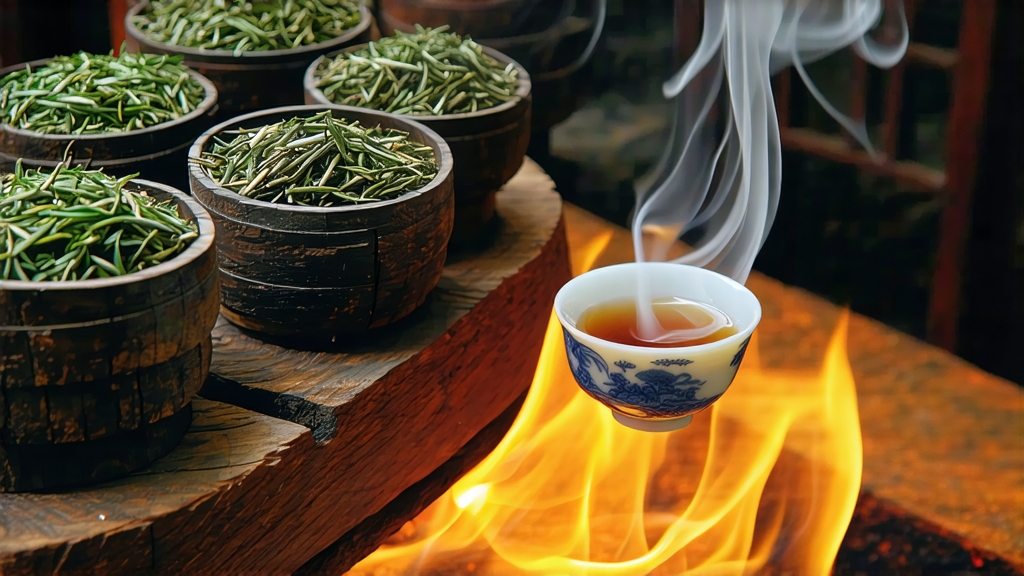
If every tea has a birthplace, then the cradle of black tea is the rocky, mist-locked Wuyi Mountains of northern Fujian. There, in the small village of Tongmu, Lapsang Souchong was born during the late Ming dynasty—an accident of war, legend says, when soldiers commandeered a tea factory and the anxious farmers, desperate to dry their leaves before they spoiled, dried them over open pine fires. The resulting tea, dark, smoky, and sweet, traveled down the Nine-Dragon River to the port of Xiamen, where Dutch merchants christened it “bohea” and shipped it to London cafés that had never tasted anything so bold. In the smoky coffee-houses of Restoration England it became the “English breakfast” prototype; in the courts of Catherine of Braganza it sparked the fashion for tea-drinking that would reshape global trade. Thus Lapsang Souchong is not merely a tea; it is the progenitor of every black tea on earth.
Geography still governs authenticity. Only leaf plucked within the 600–1,200 m core zone of Tongmu—an area of 56 km² ringed by granite cliffs and cedar–pine forest—may legally be sold as “Zheng Shan Xiao Zhong,” the protected-origin name that Europeans translate as Lapsang Souchong. The cultivar is overwhelmingly the small-leaf “cai cha” group, a Camellia sinensis var. sinensis landrace that has acclimated to mineral-rich, coarse gravel soil. Spring mornings there are 10 °C cooler than in the lowlands, so the buds synthesize more amino acids and less catechins, yielding a naturally sweet, low-astringent cup that can absorb smoke without turning harsh.
Two styles now coexist, divided by the decision to smoke. The traditional, or “smoked,” version is crafted only after the Qingming festival when two leaves and a bud are plucked at dawn. The leaves are first withered over gentle pine embers in two-storey wooden sheds; the rising heat carries resinous smoke through slatted bamboo floors, desiccating the leaf while impregnating it with volatile terpenes—α-pinene, longifolene, limonene—that later translate into aromas of smoked apricot, pine honey, and winter campfire. Once 65 % of moisture is driven off, the leaves are rolled on rattans screens until the cell rupture rate reaches 80 %, initiating oxidation. The rolled leaf is then placed in deep bamboo baskets, covered with wet cloths, and left in a 26 °C, 85 % humidity room for three to four hours. During this “sweating” phase the catechins oxidise to theaflavins and thearubigins, turning the leaf from jade to copper. A final charcoal bake, again using resinous Masson pine, halts oxidation and fixes the smoky signature. By contrast, the “unsmoked” or “new craft” Tongmu Xiao Zhong, invented for the modern Chinese domestic market, is withered naturally in heated rooms, baked over charcoal from lychee wood, and never touches pine smoke; it tastes of longan fruit, malted cocoa, and mineral spring water, proving that the same terroir can speak two entirely different dialects.
Brewing Lapsang Souchong is an exercise in calibrating smoke rather than avoiding it. For the classic smoked style, use 4 g of leaf in a 120 ml porcelain gaiwan, water at 95 °C, and begin with a lightning 5-second “wash” that is discarded; this rinse blooms the leaf and carries off any surface tar. The first proper infusion, 10 seconds, releases a liquor the colour of late-autumn sherry. Bring the cup to your nose before you sip: top notes are pine sap and dried persimmon, then comes a surprising floral lift reminiscent of narcissus, a signature of Wuyi’s native flora. On the palate the smoke behaves like Islay whisky—present but integrated, framing rather than masking flavours of dark honey, baked plum, and a faint cooling camphor finish. Subsequent steeps lengthen by 5-second increments; the tea will yield seven clear infusions before the smoke recedes and cocoa malt remains. If you prefer Western style, 2.5 g per 250 ml